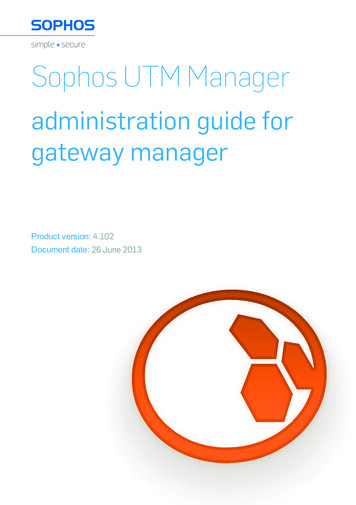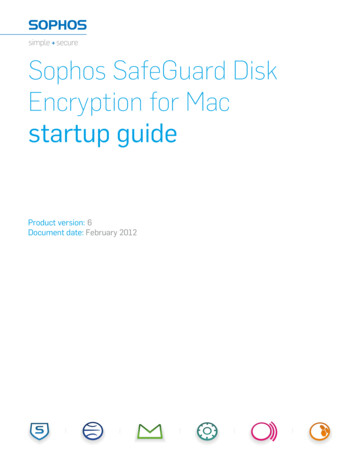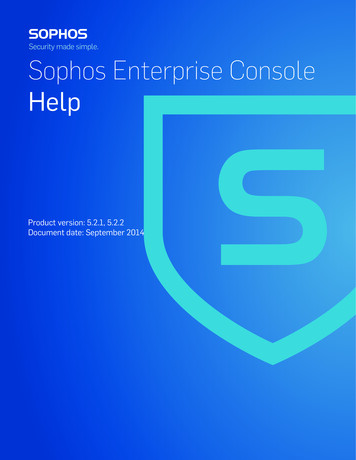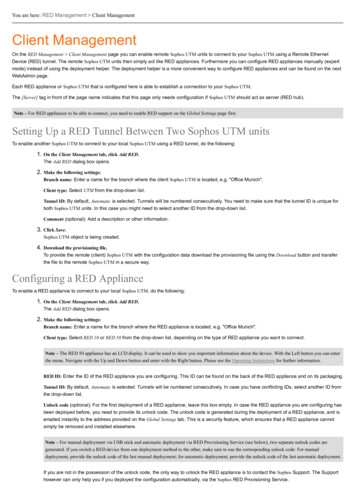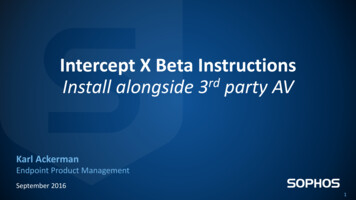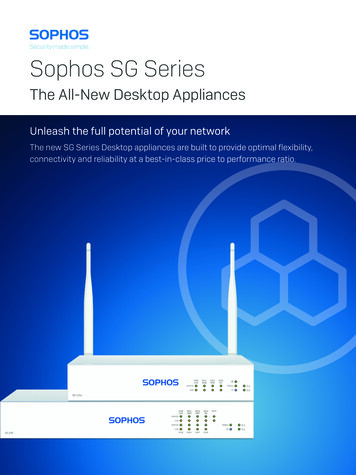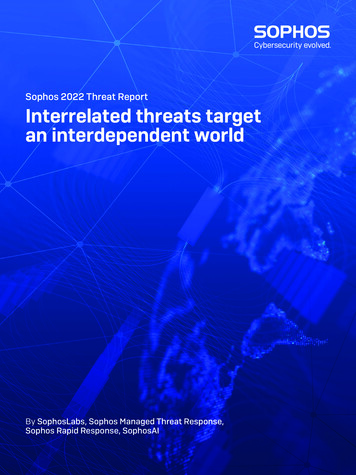
Transcription
Sophos 2022 Threat ReportInterrelated threats targetan interdependent worldBy SophosLabs, Sophos Managed Threat Response,Sophos Rapid Response, SophosAI
Sophos 2022 Threat ReportContentsLetter from the CTO2The future of ransomware4Ransomware-as-a-service subsumes attacks by solo groups4Expanding extortion6Malware begets malware8The rise of Cobalt Strike8Malware distribution frameworks9Shotgun attacks, with pinpoint targetingSecurity and AI in 2022 and beyond1012AI in 202112AI is increasingly accessible to threat actors12The ongoing surprises from AI13Unstoppable mobile malware15Catching Flubot: it’s pretty serious15Fake iPhone finance apps steal millions from vulnerable users16Why so serious about Joker Android malware?18Infrastructure under attack19Initial access brokers deliver victims to attackers19New threats target Linux, IoT devices20Attackers turn to commercial tools21The year of computing dangerously22Malware bypasses international sanctions23November 20211
Sophos 2022 Threat ReportJoe LevySophos CTOLetter from the CTOFor most of its history, cybersecurity products focused primarily on stopping maliciouscode from getting to and running on computers. What started out as hobbyist projectsto eliminate nuisance viruses on floppy disks has evolved into a multibillion-dollarcybersecurity industry with the goal to protect the internet-connected machinery of themodern world.As we’ve matured, however, we’ve observed the understanding that prevention isn’tperfect transform into a kind of provocative capitulation, which confused imperfectionwith futility.In the past decade, the pendulum swung hard in the direction of detection, whichstimulated a much-needed rapid maturation of detection capabilities, and we’re all betteroff for it. But having made such progress toward its goal, it’s time for the overcorrection toreturn to a state of equilibrium.As a leading software-as-a-service (SaaS) platform for cybersecurity, Sophos neverwavered from its mission to detect, block, and remove malicious code and instructionsfrom computers.In the past 18 months, the company has been going through a period of transformativechange, not to swing the pendulum all the way from the prevention to the detection endof the spectrum, but to bring that pendulum back to the center. We don’t see it as either amalware problem or an adversary problem: we see it as both.The meaning behind “an ounce of prevention is worth a pound of cure” has never beenmore important, especially in an era where a single machine executing unwantedinstructions can give criminals the foothold they need to hold entire industries to ransom.The speed with which modern attacks unfold makes it even more important to throwup roadblocks that slow down an adversary, because a system that requires hands-onkeyboards within seconds or minutes 24x7x365 is bound to fail. We don’t believe that weshould cede ground to those who wish to harm us, so we haven’t given up on prevention.Another reason Sophos consistently improves upon its tools that eliminate malware,while embarking on a journey to create a platform that gives us real-time visibility intowhat attackers are doing, is the sheer volume of attacks. Prevention is critical to conservescarce resources so that they are available to focus on the larger, more devastatingattacks that require a human response.Better protection helps burn down the haystack, revealing the needles that need extraattention.November 20212
Sophos 2022 Threat ReportWe introduced our Rapid Response service in 2020 to help the market counterthe ongoing threat of hands-on-keyboards adversaries. Combined with significantinvestments made by SophosLabs in behavioral protection logic and technology forearly attack disruption, it has saved hundreds of customers from attacks they otherwisewouldn’t have discovered until it was too late.In 2021, we launched the Adaptive Cybersecurity Ecosystem, the SaaS securityoperations platform that powers our Extended Detection and Response (XDR) productand our Managed Threat Response (MTR) service, with the familiar Sophos Centralinterface. This enhanced our ability to obtain real-time telemetry from endpoints, servers,firewalls, and cloud workloads to give customers and our MTR and Rapid Response teamsa leg up on threat actors.The technology industry uses the term shift left to indicate that, when a business cantackle a problem early on, rather than letting it fester, that business can save itself a lotof time, money, and debt. You can’t effectively secure an application if you introducesecurity at the end of the development process, and you can’t effectively secure systemsor networks if you surrender the idea that better prevention is achievable, or if you believethat either prevention or detection, alone, can solve modern problems in informationsecurity.Sophos’ combined efforts on developing a groundbreaking, cross-platform detectioncapability, while investing in industry-leading technology to block and remove malwarebefore it can cause harm, is the first step in our shift left plans at Sophos.For five years, Sophos has been building out its data science operation based on strongprinciples of transparency and scientific rigor. The data science team helped designembedded machine learning malware detection that has improved our ability to discernbetween benign files and malware, reducing false positives and detecting novel andexotic malicious code that might have otherwise evaded notice.The next step for our data science team is to leverage the Adaptive CybersecurityEcosystem, curating its information to train and deliver to the industry the firstsecurity operations recommendation engine that will help guide security operations.Recommendation engines operate in our daily lives now, guiding us to products we mightwant to buy or television we want to watch. They make our lives better in myriad ways. Asecurity recommendation engine won’t replace the live people who protect our networksand computers, but it will help guide their decisions to prioritize, triage, and respond toincidents.We live in an attention economy, and while no single vendor can solve our industry’scybersecurity skills shortage, we can optimize the attention of the people we have.Sophos operates on principles of being the most credible, the most transparent, andthe most scientifically rigorous cybersecurity company in the industry. We believe thatshifting the timescale of attack mitigation left, from weeks, to days, to minutes – with theguidance of AI-enhanced security operations – will transform the security industry andput cybercriminals at a constant disadvantage.November 20213
Sophos 2022 Threat ReportThe future of ransomwareRansomware has staked its claim as a major element of the cybercriminal ecosystem. As one of the mostpotentially damaging and costly types of malware attacks, ransomware remains the kind of attack thatkeeps most administrators up at night, a Keyser Söze of the internet. As we move into 2022, ransomwareshows no sign of slowing down, though its business model has gone through some changes that seemlikely to persist and even grow over the coming year.Ransomware-as-a-service subsumes attacks by solo groupsOver the past 18 months, the Sophos Rapid Response team has been called in to investigate and remediatehundreds of cases involving ransomware attacks. Ransomware isn’t new, of course, but there have beensignificant changes to the ransomware landscape over this period: the targets have shifted to ever-largerorganizations, and the business model that dictates the mechanics of how attacks transpire has shifted.The biggest change Sophos observed is the shift from “vertically oriented” threat actors, who make andthen attack organizations using their own bespoke ransomware, to a model in which one group builds theransomware and then leases the use of that ransomware out to specialists in the kind of virtual breakingand-entering that requires a distinct skill set from that of ransomware creators. This ransomware-as-aservice (or RaaS) model has changed the landscape in ways we couldn’t predict.Sophos Rapid Response, reason for incident response engagements 2020-2021Misc. malware 5%Miners 3%Data exfiltration 3%Web shells 4%Cobalt Strike 6%Ransomware 79%Fig 1. While ransomware attack response accounted for most of the incidents the Sophos Rapid Response team was involved in during thepast year, it didn’t account for them all. Removal of Cobalt Strike Beacons, cryptominers, and even web shells also prompted extra attention,especially in the days following the revelations of the ProxyLogon, and later ProxyShell, exploits, which resulted in a lot of people quicklybecoming familiar with how dangerous a web shell could be.For instance, when the same group crafted and attacked using their own ransomware, those threat actorstended to engage in unique and distinctive attack methods: one group might specialize in exploitingvulnerable internet-facing services like Remote Desktop Protocol (RDP), while another might “buy” accessto an organization previously compromised by a different malware group. But under the RaaS model, allthese distinctions in the finer details of how an attack takes place have become muddled and make it moredifficult for incident responders to identify exactly who is behind an attack.November 20214
Sophos 2022 Threat ReportIn 2021, a disgruntled affiliate of the Conti RaaS service, unhappy with how they were treated by theransomware creators, published an archive that included a rich trove of documentation and guidance(mostly written in Russian) designed to instruct an attacker “affiliate” in the steps required to conduct aransomware attack. These documents, and the tools they included, give detailed insight into the attackmethods that most of these RaaS affiliates will employ. They also demonstrated why, in some cases, wesaw what we expected were different attacker groups employing virtually identical tactics, techniques, andprocedures (TTPs) during their ransomware attacks.This “normalization” of ransomware TTPs corresponds with the wide public release of the Contidocumentation and has now spread to other RaaS threat actors, many of whom have been following theConti playbook and meeting with some measure of success.The publication of the playbook has also benefited Sophos customers. As a result of a long analysis of thecontents and instructions, SophosLabs has been able to hone the behavioral detection rules that governwhen specific sets of actions detected on an endpoint indicate that an attack is likely in progress. This hasled to a vastly more capable product that alerts customers, administrators, and the MTR service when thoseactivities look like the precursors to a ransomware attack.Sophos believes that, in 2022 and beyond, the RaaS business model will continue to dominate the threatlandscape for ransomware attacks, as this model permits experts in ransomware construction to continueto build and improve their product, while giving experts in “initial access” break-ins the ability to focus on thistask with increasing intensity. We’ve already seen these RaaS threat actors innovate new ways to break intoprogressively more well-defended networks, and we expect to see them continue to push in this direction inthe year to come.Ransomware families investigated by Sophos Rapid Response, 2020-2021Conti infection rate portends the expansion of the RaaS modelConti 16%All other ransomware(35 different “families”) 43%REvil 15%Ryuk 9%Black Kingdom 3%DarkSide 3%Maze 3%Ragnarok 4%LockBit 4%Fig 2. Nearly four in five calls to Sophos Rapid Response service came as the result of a ransomware attack, and among those calls, Contiwas the most prevalent ransomware we encountered, at 16% of engagements. The next most frequent were the three Rs – Ryuk, REvil,and Ragnarok – who together accounted for the next 28% of attacks. Among the remaining 56% of incidents, we encountered ransomwareunder 39 different names.November 20215
Sophos 2022 Threat ReportExpanding extortionRansomware is only as good as your backups, or so an adage might go if any existed. The truth of thisstatement became the basis for one of the most devastating “innovations” pioneered by some threat actorgroups involved in ransomware schemes in the past several years: the rise of extortion in ransomwareattacks.Increasingly, large organizations have been getting the message that ransomware attacks were costly butcould be thwarted without the need for a ransom payment – if the organization kept good backups of thedata the attackers were encrypting and have been acting on it by engaging with large cloud backup firmsto keep their systems cloned. After all, if, for instance, you only lost one day’s worth of work, it would be amanageable loss, completely survivable for the targeted organization, if they chose to restore from backupsrather than pay the ransom.Fig 3. Atom Silo, like many ransomware threat groups, engages in extortion with a threat of leaking sensitive information, as well asmaliciously encrypting filesWe have to presume that the ransomware groups were also getting the message because they weren’tgetting paid. They took advantage of the fact that the average “dwell time” (in which they have accessto a targeted organization’s network) can be days to weeks and started using that time to discover anorganization’s secrets—and move everything of value to a cloud backup service themselves. Then, when theransomware attack struck, they’d layer on a second threat: pay up or we release your most sensitive internaldocuments, customer information, source code, patient records, or, well, anything else, to the world.It’s a devious ploy and one that put ransomware attackers back on their feet. Large organizations not onlyface a customer backlash – they could fall victim to privacy laws, such as the European GDPR, if they fail toprevent the release of personally identifiable information belonging to clients or customers, not to mentionthe loss of trade secrets to competitors. Rather than risk the regulatory (or stock price) fallout from sucha disclosure, many of the targeted organizations chose to pay (or have their insurance company pay) theransom. Of course, the attackers could then do whatever they wanted, including selling that sensitivecompetitive data to others, but the victims found themselves unable to resist.November 20216
Sophos 2022 Threat ReportThere have been cases, however, where the normal forms of ransom and extortion were still insufficientmotivation for the victims to pay a hefty ransom. In a limited number of cases, the Sophos Rapid Responseteam was informed by the victim organization that they’s begun to receive phone calls or voicemails fromsomeone who claimed to be associated with the ransomware attackers, repeating the threat that theattackers would publish the victim’s internal data unless they received their ransom payment.And as 2021 moved to a close, at least one ransomware group published a press release (of sorts) thatstated they would no longer work with professional firms that negotiate on behalf of businesses withransomware attackers. The overt threat leveled against ransomware targets was this: If you speak with or goto the police or work with a ransomware negotiation firm, we will instantly release your information.There have been some bright spots on the horizon, however. In September 2021, the U.S. TreasuryDepartment enacted financial sanctions against a Russia-based cryptocurrency broker and market, whichthe government alleges had been widely used as an intermediary for ransom payments between victimsand attackers. Small steps such as this may offer a short-term solution, but for most organizations, weremain consistent on our basic advice: it’s far better to avert a ransomware attack by hardening your attacksurfaces than to have to deal with the aftermath.Sophos expects that threats of extortion over the release of data will continue to be a part of the overallthreat posed by ransomware well into the future.November 20217
Sophos 2022 Threat ReportMalware begets malwareThe rise of Cobalt StrikeCobalt Strike is a commercially-produced exploitation tool suite intended for “threat emulation” – recreatingthe types of techniques used by malicious actors. First released in 2012, it is commonly used by penetrationtesters and corporate red teams as part of the “offensive security” toolbox.The business end of Cobalt Strike is its Beacon backdoor, which can be configured in several ways toexecute commands, download and execute additional software, and relay commands to other Beaconsinstalled across a targeted network. Beacons can be customized to emulate a wide variety of threats.Unfortunately, they can also be used with ill intent. In fact, the Beacons do such a good job, criminals onlyneed to make minor modifications to the source code in order to leverage the Beacon as a foothold on aninfected machine.That’s become a major concern over the past few years, as leaked copies of the suite’s source code, cracksin its licensing structure, and pirated full versions of Cobalt Strike have found their way into the hands of avery different kind of user from the product’s intended customer base.The increasing popularity of Cobalt Strike Beacons among 2021FebMarAprMayJunJulAugSepMonthFig 4. Beacons are a key feature of the Cobalt Strike attack suite, providing a capable backdoor to Windows machines. The malware appearsas a payload of “conventional” malware such as Trickbot, IcedID, or BazarLoader, and features prominently in hands-on-keyboard attackincidents investigated by Sophos Rapid Response.Hacked Cobalt Strike suites have become the Saturday Night Specials of cybercrime: they are widelyavailable on underground marketplaces and can be easily customized. There’s ample training and sampleconfigurations available on the internet to make getting started with Cobalt Strike relatively trivial forcybercriminals. And recently, malicious actors have used access to Cobalt Strike’s source code to port itsBeacon backdoor to Linux.November 20218
Sophos 2022 Threat ReportAs a result, most of the ransomware cases we’ve seen over the last year have involved the use of CobaltStrike Beacons. While many malware operators use backdoors associated with the open source Metasploitframework, Cobalt Strike Beacons have become the favored tool of ransomware affiliates and accessbrokers who sell compromises to ransomware gangs and are often seen tied to ransomware execution.We’ve also observed other malware operators, including the cryptocurrency miner LemonDuck, using CobaltStrike as part of their access and lateral movement.In some cases, Beacons are dropped by malicious documents in spam or other installers, or through serverexploits that allow the Beacons to be remotely installed and launched (as we saw in a recent Atom Siloattack.) In others, Beacons are used for much of the further penetration of the network and to execute theransomware itself.We anticipate this trend will continue. Tools such as Cobalt Strike make it easier for ransomware gangs toscale up operations, using playbooks and tools to guide affiliates through achieving their goals, and moreintrusions are likely to be powered by Beacons as a result.Malware distribution frameworksOver time, the families we see as the top “commodity” malware – widely distributed, heavily spammed –have changed quite dramatically. Just 18 months ago, the Emotet family was considered the most widelydistributed malware in the world, but then the Emotet gang just closed up shop, and there’s been a fight fordominance among the rest of the competitors ever since.Emotet brought to the forefront the role of malware not just as a tool to remotely access an infectedmachine, or as a way to steal passwords, but to serve a place in the malware ecosystem that nobodyexpected: it became a sort of criminal content distribution network (CDN), similar in principle to those usedby major internet portals but used exclusively for malware. Criminal groups could then contract with Emotetto push their malware out to Emotet’s massive network of infected PCs.Since Emotet’s disappearance, SophosLabs has followed along as several other malware families haveswitched their business model to that of a malware distribution network. One of the families we most oftensee engaging in this behavior is called IcedID, a spam-delivered malware family that (like Emotet) takesadvantage of the fact that millions of PCs are infected with the malware, and whose operators appear tolease out use of portions of those infected computers to push other groups’ malware onto the machines.The long-lived TrickBot malware also served as a malware distribution platform, even after Microsoft and lawenforcement collaborated to take down some of its command-and-control infrastructure. While TrickBot stillexists, its creators have moved forward with a next generation botnet they call BazarLoader, which is used todeliver malware payloads on behalf of both its own operators and other groups.Likewise, a malware now known as Dridex (but which started out as something called Cridex) has beenaround for almost a decade. Dridex started as a bank credentials-stealer and evolved over time to become acore piece of Evil Corp’s malware distribution framework.At the end of 2020, criminals had stolen the source code for Cobalt Strike, and published the source codeto Github. As we mention in the previous section, Cobalt Strike Beacons are widely used by adversaries. Notsurprisingly, therefore, Beacons are among the most frequently encountered malware payloads of variousmalware distribution networks.November 20219
Sophos 2022 Threat ReportBecause many of the most widely distributed malware families also turn an infected machine into apotential destination for Cobalt Strike or malware payloads, it’s unlikely that the malware distributionframework aspect of these malware families will ever go away. Unfortunately, that means thatadministrators and security teams need to treat even minor malware alerts promptly, as any infection, nomatter how seemingly insignificant, may simply be the start of a much more devastating cyberattack.Gootloader detections drop after 2021 report publicationDetections of the malicious-SEO malware drop precipitously within weeks of our analysis300250Count200150100500Jan 42021Feb 1Mar 1Apr 5May 3Jun 7Jul 5Aug 2Sep 6Oct 4MonthAMSI/GootLdr-AAMSI/Reflect-HFig 5. Gootloader malware relies on the effectiveness of its ability to poison Google search results in order to spread, and a few weeks afterthe March 1, 2021 publication of our report about the malware group’s activities, we saw a sharp drop in the number of machines witheither a detection of the malware loader or the “reflective loading” behavior it engages in to filelessly infect machines.Shotgun attacks, with pinpoint targetingIn past years, we were able to break down attacks into two broad categories. The first: shotgun attacks,in which the threat actors might spam absolutely everyone, or use search engine optimization (SEO)techniques to drive search engine users to malicious web pages. And second: highly targeted attacks, inwhich the attackers have done some homework and go into the attack with foreknowledge about the targetorganization, the people who make up that organization, and which of those people might be juicy targets.But in 2021, we saw the emergence of a hybrid category: a broad-based attack meant to lure in lots ofpeople, but that only fires off when the unlucky people who stumble into the trap meet certain criteria.This may seem counterintuitive, but from the criminals’ perspective, it makes some sense: they can blockmalware analysts from continuing to probe their servers, and they also reduce suspicion by keeping thenumber of attacks relatively low, under the radar that might otherwise tip off security researchers or ITadmins to a wider campaign.We saw one example this year with the malware known as Gootloader. The people behind Gootloader havecreated a broad-based attack using malicious SEO techniques, luring in potential victims who might belooking for a specific kind of legal or technical document when they search for them on Google.November 202110
Sophos 2022 Threat ReportHowever, the Gootloader threat actors have also established a system that limits the volume of potentialvictims. For one, they only engage in their poisoning of search terms in four languages: English, German,French, and Korean Hangul. For another, they filter by the region of the world the potential victim is visitingfrom, using IP geolocation to restrict English-speakers who may be surfing from Australia (for instance)rather than the United States or Canada.Further, in the course of the script-driven attack, the criminals profile the potential victim’s computerhardware and software, and hold out for specific configurations so mobile surfers or those browsing on acomputer with a non-Windows operating system get bumped off the list. Finally, they track the IP addressof every visitor that gets caught in their malicious SEO snare, and block not only the visitor’s IP address fromreturning more than once but an entire IP address range from repeat visits.Another threat actor group, responsible primarily for spreading a malware family called BazarLoader, hasalso taken a dramatically different approach to spreading its malware. The threat actors rely on massivevolumes of spam email, but the spam doesn’t contain a file attachment or a malicious link. In fact, there maybe nothing inherently malicious in their spam messages at all. Many of them appear to be invoices for largepurchases, with no way to contact the putative retailer other than via a telephone number in the message.When the spam recipient calls the number, they end up speaking with someone who will perform a kindof psychological profiling on the caller, to determine whether they’re likely to be a real victim, or if they’rea security researcher or otherwise incredulous person. Over the course of making dozens of these calls,SophosLabs researchers found that the live humans who answer the telephones will eventually block thecaller ID for numbers that call back multiple times.But if the caller is sufficiently convincing – which seems to require a combination of being moderately angryand acting like a bit of a neophyte with limited computer knowledge – then the operators who answer thecalls walk the victims into a trap, guiding them to visit websites that deliver not a resolution, but rather amalicious, infectious file to open and run, often disguised as some sort of refund request.Threat actors like Gootloader and BazarLoader seem to be content with spreading their attacks widely andthen taking a quality-filter approach to whatever makes it past the first stage of the attack. SophosLabsbelieves that this may represent a novel way for malware distributors to thwart malware researchers whilegiving themselves a greater degree of certainty that their malware is going to a subset of victims that maybe more desirable than the general population. We expect to see a wider adoption of these techniques withsome malware families going into 2022 and beyond.Fig 6. Gootloader attacks begin when the victim searches for terms the attackers have “poisoned” in Google results, usually involving legaldocumentation. The malicious SEO promotes web sites the attackers control high in the result rankings, delivering visitors to those sitesinto a trap that looks exactly like this contrived “message board,” which delivers the infectious payload.November 202111
Sophos 2022 Threat ReportSecurity and AI in 2022 and beyondAI in 2021In 2021, AI technologies that were only recently considered cutting edge (e.g., AI that generates realistic buttotally fabricated images and text) became accessible to non-expert developers, poising them to enter thelexicon of adversary deception tactics. It was also a year in which new AI breakthroughs, such as OpenAIand Google’s AI systems that write working, college-level source code, promised continued AI impact on theway the cybersecurity game is played. And it was the year in which Google DeepMind demonstrated that itsAlphaFold deep learning approach had solved the protein structure prediction problem, seminal work that’sbeen compared to the sequencing of the human genome.Within the security product community, 2021 was the year that marked the completion of an era ofparadigm-shift within the industry, when it came to recognize machine learning (ML) as an indispensablefactor in modern detection pipelines, shifting towards integrating ML as a first-class citizen alongsidetraditional detection technologies. In the 2020s, the mere fact that a vendor uses ML in a particularprotection technology will not be noteworthy – it will be table stakes. The real question will be how effectivecompanies’ AI detection solutions are, and what novel capabilities, outside autonomous detectionworkflows, security companies are developing with AI.AI is increasingly accessible to threat actorsAs we began this decade, AI consolidated its transition from a specialist discipline to a technologyecosystem in which advanced research labs’ successful prototypes quickly become open-source softwarecomponents accessible to both benign software developers and malevolent adversaries.For example, OpenAI’s GPT-2 text generation model, which OpenAI kept under lock –and key in 2019 toprevent its use by bad actors, has now been reproduced by independent researchers and can be spun upfor use by the general public, with startups like HuggingFace and Amazon’s SageMaker service pioneering akind of point-and-click AI service for content providers.Bigger neural networks are better at solving problemsFig 7. In the study “
security operations recommendation engine that will help guide security operations. Recommendation engines operate in our daily lives now, guiding us to products we might want to buy or television we want to watch. They make our lives better in myriad ways. A security recommendation engine won't replace the live people who protect our networks
